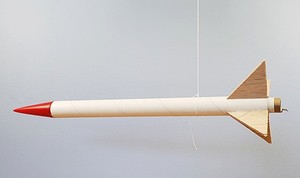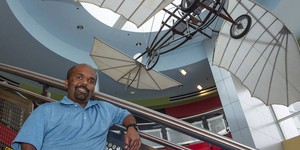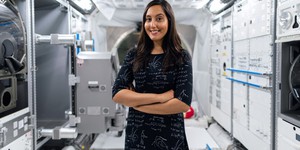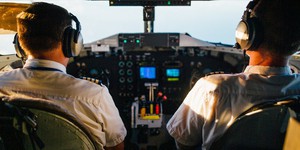Abstract
What keeps a model rocket on course? How can you make sure a model rocket design is stable before you launch it? Find out in this project as you learn about center of mass, center of pressure, and their effect on a rocket's stability.Summary

Objective
Determine how fin size affects model rocket stability.
Introduction
Model rockets come in a variety of shapes and sizes (Figure 1). A basic model rocket consists of the rocket's body, the nose cone, a recovery system (like a parachute), the fins, and the engine (also called the motor or propellant), along with some additional components, as shown in Figure 2.
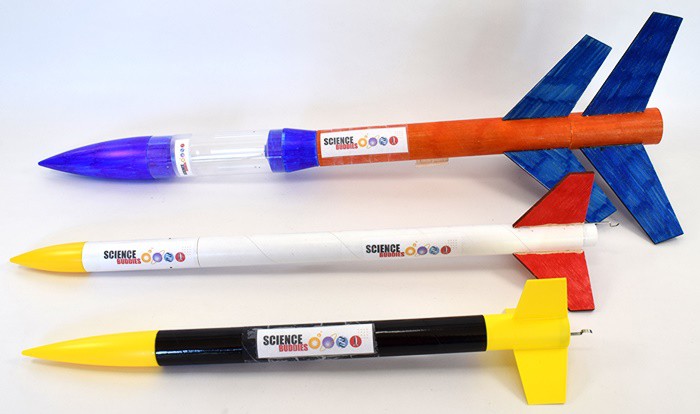 Image Credit: Ben Finio, Science Buddies / Science Buddies
Image Credit: Ben Finio, Science Buddies / Science Buddies
Figure 1. Three different types of model rockets. From top to bottom: the Estes Loadstar II, the Apogee Research Express, and the Apogee Apprentice.
 Image Credit: Ben Finio, Science Buddies / Science Buddies
Image Credit: Ben Finio, Science Buddies / Science Buddiescross-sectional diagram of a model rocket. The rocket's body is represented by a horizontal rectangle. The rocket's nose cone is a triangle attached to the left end of the rectangle. The parachute, recovery wadding, and engine are shown inside the body. The launch lug is a small rectangle attached to the side of the rocket. The fins are triangular pieces attached to the bottom of the rocket.
Figure 2. Cross-sectional diagram of a basic model rocket. Note: This diagram does not show every single part of the rocket. Read the instructions that come with your rocket for assembly details.
The parts of the rocket all contribute to determining the location of its center of mass (COM). An object's center of mass is the equivalent point at which the object acts like all its mass is concentrated. You can think of the center of mass as an object's "balance point." In order to balance an object on your finger, its center of mass must be directly above your finger, otherwise, it will tip to the side and fall (Figure 3).
 Image Credit: Ben Finio, Science Buddies / Science Buddies
Image Credit: Ben Finio, Science Buddies / Science Buddiesthree rectangular beams balanced on top of three triangles. Each beam has a circle at its geometric center representing its center of mass. One beam's center of mass is directly over the tip of the triangle, so it is balanced. The other beams' centers of mass are offset from the tip of the triangle, causing them to tip to the side.
Figure 3. Only the middle object is balanced, because the center of mass is directly above the pivot. The other two objects will fall to the side.
For an object made from a single, uniformly dense material, the center of mass is at its geometric center, or centroid. However, rockets are made from multiple parts with different densities. For example, the engine is much heavier than the parachute. This brings the center of mass closer to the rear of the rocket, as opposed to its geometric center (Figure 4). Note: Sometimes the term center of gravity (CG) is used interchangeably with center of mass. In a uniform gravitational field, the center of gravity and center of mass are the same.
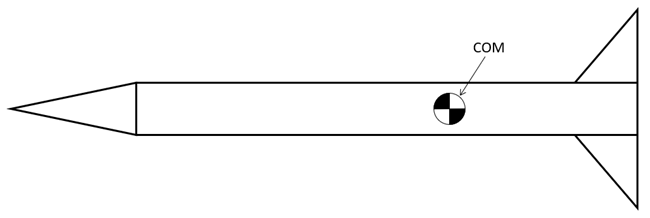 Image Credit: Ben Finio, Science Buddies / Science Buddies
Image Credit: Ben Finio, Science Buddies / Science Buddies
Figure 4. A rocket's center of mass is closer to its rear due to the relatively heavy engine.
The shape of the rocket determines its center of pressure (CP), or the equivalent point at which the aerodynamic forces of lift and drag act. Unlike center of mass, center of pressure does not depend on an object's density, only its shape. Again, for a perfectly symmetrical object, the center of pressure will be at the centroid, but model rockets are not symmetrical. They have fins that add more surface area to one end. The fins bring the center of pressure closer to the back of the rocket (Figure 5).
 Image Credit: Ben Finio, Science Buddies / Science Buddies
Image Credit: Ben Finio, Science Buddies / Science Buddiesa rocket moving to the left, tilted at a slight angle to the direction of motion. A circle marks the rocket's center of pressure, which is close to its fins at the rear of the rocket. Arrows represent the lift and drag forces, acting perpendicular and parallel to the direction of motion respectively.
Figure 5. The rocket's fins bring the center of pressure closer to the rear of the rocket.
When you launch a model rocket, you want its flight to be stable. In other words, you want it to fly (relatively) straight up, not turn sideways and fly into a group of spectators! In order for a rocket to be stable, the center of pressure must be located behind the center of mass (closer to the rear). This way, if the rocket is not flying perfectly straight (it has a non-zero displacement angle), the lift and drag forces will generate a restoring torque about the center of mass (Figure 6). This torque points the rocket's nose back in the correct direction. If the center of pressure is in front of the center of mass, then the torque will continue to push the rocket off course, and the rocket will be unstable.
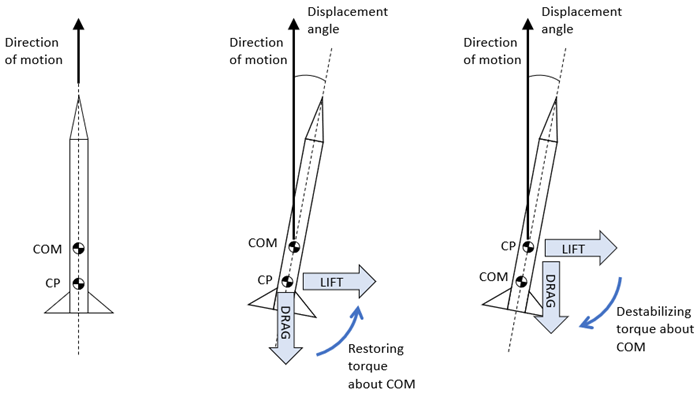 Image Credit: Ben Finio, Science Buddies / Science Buddies
Image Credit: Ben Finio, Science Buddies / Science Buddies
Figure 6. Left: the rocket's nose cone points exactly in the direction of motion, so there is no net aerodynamic torque about the center of mass. Center: the center of pressure is behind the center of mass. When the rocket flies at an angle, the lift and drag forces generate a restoring torque about the center of mass, and the rocket is stable. Right: the center of pressure and center of mass have been switched (COP is in front of COM). In this case, when the rocket flies at an angle, the lift and drag forces generate a torque that tends to increase the displacement angle, making the rocket unstable.
How do you make sure a model rocket design is stable before you launch it? You certainly do not want to find out the hard way that your rocket is unstable. An unstable rocket is a hazard to spectators and possibly nearby property. Luckily, there is a simple test you can do to make sure a model rocket is stable before you launch it. In this project, you will change your rocket's fin size and use this test to determine how fin size affects stability. See the Variations section for ideas about other variables you can change. Get ready to do some rocket science!
Terms and Concepts
- Nose cone
- Recovery system
- Fin
- Engine
- Center of mass
- Centroid
- Center of gravity
- Center of pressure
- Lift
- Drag
- Stable
- Displacement angle
- Restoring torque
- Unstable
Questions
- Which forces act on a model rocket during flight?
- What determines the location of a rocket's center of mass?
- What determines the location of a rocket's center of pressure?
- What determines whether a rocket is stable or unstable?
Bibliography
These references provide introductory information about model rockets:
- NAR. (n.d.). The National Association of Rocketry. Retrieved August 3, 2020.
- Apogee Components. (n.d.). New to Model Rocketry?. Retrieved August 3, 2020.
- NASA. (n.d.). Guided Tours of the Beginner's Guide to Aeronautics (BGA). Retrieved August 3, 2020.
- Stine, G.H. and Stine, B. (2004, April 22). Handbook of Model Rocketry, 7th Edition. John Wiley & Sons, 2004.
These references explain more about center of mass and center of pressure:
- Khan Academy (n.d.). What is center of mass?. Retrieved August 10, 2020.
- NASA (n.d.). Center of Pressure - cp. Retrieved August 10, 2020.
- NASA (n.d.). Determining Center of Pressure - cp (simplified). Retrieved August 10, 2020.
These references give an explanation of model rocket stability:
- Van Milligan, T. (2018, February 6). Model Rocket Stability. Apogee Components Peak of Flight Newsletter. Retrieved August 10, 2020.
- NASA (n.d.). Rocket Stability. Retrieved August 10, 2020.
Materials and Equipment
Model rocket supplies are available at many hobby stores. Supplies are also available from Estes Rockets and Apogee Components.
- Model rocket where you can make your own fins.
- Avoid kits with pre-assembled plastic tail sections for this project.
- The procedure for this project will be slightly easier for rockets with four fins than for rockets with three fins.
- Extra balsa wood to make multiple sets of fins
- Tools and supplies for assembling your rocket. You will need to read the manufacturer's instructions for your rocket, but these typically include a hobby knife, ruler, pencil, wood glue, and plastic cement or superglue.
- Ruler
- String
- Masking tape
- Clear tape
- Optional: Materials to finish, paint, and/or decorate your rocket, such as sandpaper, spray paint, and stickers
- Lab notebook
Technically, you can do this project without launching your rocket, but where's the fun in that? If you want to launch your rocket (after you make sure it is stable!), you will also need:
- Launch controller and launch pad
- Engines. A-sized engines are best if this is your first model rocket project. Your rocket will not go as high, but it will be easier to recover. B-sized engines and above are best for students who already have some experience with model rockets and access to a larger launch site.
- Recovery wadding
- Large, open field free of obstructions like trees and power lines in which to launch your rocket. Refer to the Model Rocket Safety Code for required launch site dimensions.
- Helpers can be useful when launching the rocket, such as a spotter to carefully watch where the rocket lands or to take photos/video from a distance while you operate the launch controller
Disclaimer: Science Buddies participates in affiliate programs with Home Science Tools, Amazon.com, Carolina Biological, and Jameco Electronics. Proceeds from the affiliate programs help support Science Buddies, a 501(c)(3) public charity, and keep our resources free for everyone. Our top priority is student learning. If you have any comments (positive or negative) related to purchases you've made for science projects from recommendations on our site, please let us know. Write to us at scibuddy@sciencebuddies.org.
Experimental Procedure
- Plan out your experiment.
- Pick a shape for your fins. Keep the shape consistent for all sets of fins.
- Decide what size fins you should test. You should test at least three different sizes. Make sure the sizes you pick are "reasonable." For example, it does not make sense to try and test fins that are longer than your entire rocket, or fins so small that you cannot cut them out of balsa wood with a hobby knife.
- Decide whether your rocket will have three or four fins. You can do this project with three fins, but it will be slightly easier with four fins.
- Prepare a data table for your results. Table 1 shows an example data table. Make sure you are consistent in how you measure the "fin size." For example, this can be the length of the side that attaches to the rocket.
| Fin size (cm) | Fin area (cm2) | Center of mass location (cm) | Center of pressure location (cm) | Should rocket be stable? (yes or no) | Stability test (Trial 1) | Stability test (Trial 2) | Stability test (Trial 3) |
|---|---|---|---|---|---|---|---|
- Cut out your three sets of fins and set them aside (Figure 7).
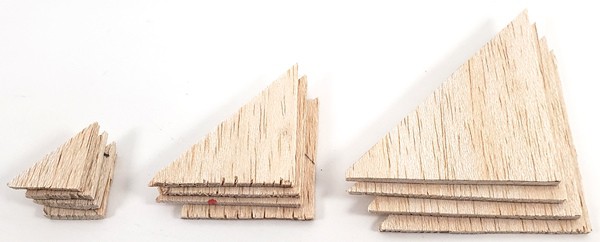 Image Credit: Ben Finio, Science Buddies / Science Buddies
Image Credit: Ben Finio, Science Buddies / Science Buddies
Figure 7. Three sets of of 45° triangular fins with 1 inch, 2 inch, and 3 inch short edges.
- Follow the manufacturer's instructions to assemble your rocket. However, do not permanently glue the fins on yet! You will temporarily attach the fins with tape so you can swap them out when doing your experiment. Make sure you load your rocket with a new engine, since the engine has a significant effect on the center of mass (Figure 8).
 Image Credit: Ben Finio, Science Buddies / Science Buddies
Image Credit: Ben Finio, Science Buddies / Science Buddies
Figure 8. A partially assembled rocket without the fins. Do not forget the engine!
- Using small pieces of tape, temporarily tape your first set of fins to the rocket (Figure 9).
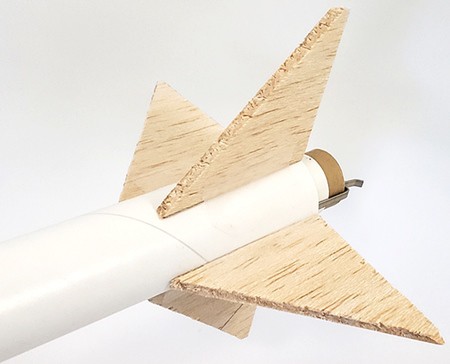 Image Credit: Ben Finio, Science Buddies / Science Buddies
Image Credit: Ben Finio, Science Buddies / Science Buddies
Figure 9. Fins taped to the rear of the rocket. Note: in this picture, the wood grain is parallel to the rocket's body. For a stronger connection, make sure the wood grain is perpendicular to the body tube when you permanently glue the fins to the rocket.
- Find your rocket's center of mass by finding its balance point. You can do this by balancing the rocket on your finger, or by tying a string around the rocket's body and moving the string until the rocket balances in the air (Figure 10). Measure the location of the center of mass, either from the tip of the nose cone or from the tail (it does not matter which one you pick, just make sure you are consistent).
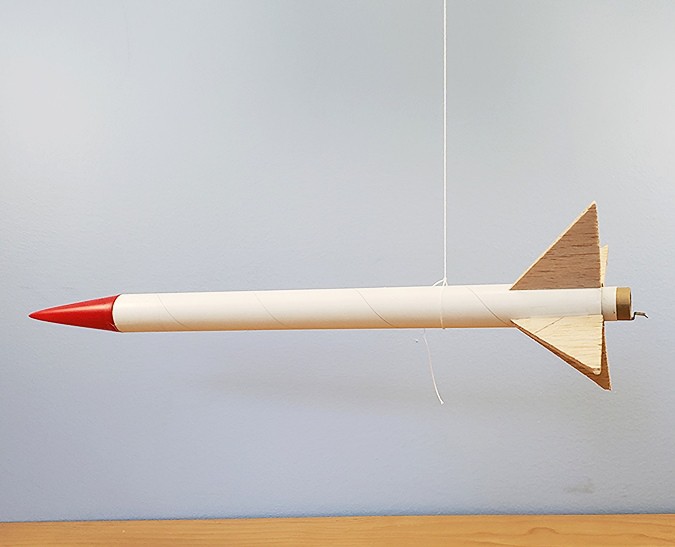 Image Credit: Ben Finio, Science Buddies / Science Buddies
Image Credit: Ben Finio, Science Buddies / Science Buddies
Figure 10. A rocket balanced while hanging from a string.
- Find your rocket's center of pressure. There are three different ways you can do this. You can choose the approach that makes the most sense to you. They all start with making a two-dimensional tracing of your rocket's shape.
- Note: if your rocket has four fins, the side view should show two full-size fins. If your rocket only has three fins, the side view will show one full-size fin and one fin that appears slightly smaller since it is at an angle.
- Cardboard method (Figure 11)
- Using a ruler, draw a two-dimensional side view of your rocket on a piece of corrugated cardboard.
- Hang the cardboard cutout from a string, and repeat the same process you used in step 6. In this case, the cardboard has uniform density, unlike the rocket which is made up of parts with different densities. The balance point that you find is the center of pressure.
- Measure the distance to the balance point and record it in your data table. Remember to be consistent about whether you measure from the nose or the tail.
- Graph paper method (Figures 12, 13)
- Using a ruler, draw a two-dimensional side view of your rocket on a piece of graph paper.
- Find the point on the rocket that has an equal number of squares to the left and to the right. This is the rocket's geometric center (centroid).
- Measure the distance to the geometric center and record it in your data table. Remember to be consistent about whether you measure from the nose or the tail.
- Centroid method (Equation 1)
- Using a ruler, draw a two-dimensional side view of your rocket on a piece of paper.
- Break your drawing up into smaller shapes where you can calculate the area, such as triangles and rectangles.
- Find the centroid of each individual shape. For a rectangle, the centroid is in the middle. For a triangle, the centroid is at 1/3 of the triangle's height from the base.
- Use Equation 1 to solve for the distance to the center of pressure and record it in your data table. Again, be consistent about whether you measure from the nose or the tail.
 Image Credit: Ben Finio, Science Buddies / Science Buddies
Image Credit: Ben Finio, Science Buddies / Science Buddies
Figure 11. A cardboard cutout of the rocket's profile.
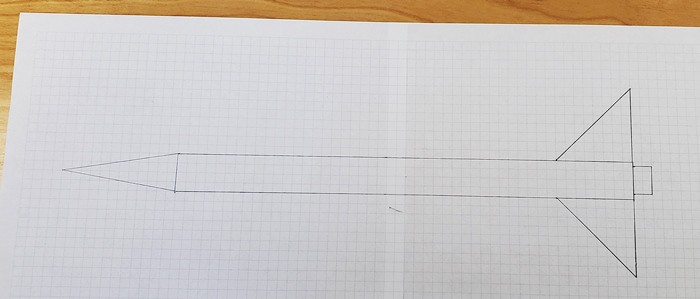 Image Credit: Ben Finio, Science Buddies / Science Buddies
Image Credit: Ben Finio, Science Buddies / Science Buddies
Figure 12. Side view of a rocket traced onto two pieces of graph paper that are taped together (the rocket is too long for one piece of paper).
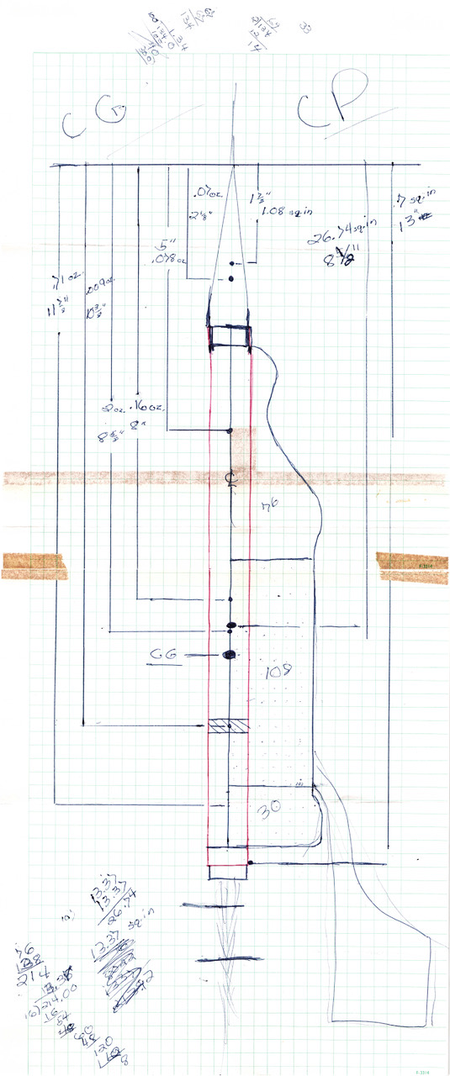 Image Credit: Ken Hess, Science Buddies / Science Buddies
Image Credit: Ken Hess, Science Buddies / Science Buddies
Figure 13. This rocket diagram was done by Science Buddies founder and CEO Ken Hess when he was a kid!
- Note: all the areas in this equation are the areas in the two-dimensional drawing, not the three-dimensional surface areas.
- dcp is the distance to the center of pressure
- dn is the distance to centroid of the nose cone
- An is the area of the nose cone
- db is the distance to centroid of the body
- Ab is the area of the body
- df is the distance to centroid of the fins
- Af is the area of both fins
- Based on your measurements, predict whether or not your rocket will be stable, and record your prediction in your data table.
- To determine whether or not your rocket is actually stable, tie a string around its body at the center of mass. Secure the string with a small piece of masking tape. Make sure the area around you is clear of people and obstacles (it is best to do this part in a large room, or outside on a calm day), and twirl the rocket around your head, as shown in this video:
- Was your rocket stable? Does this match your prediction? Record your results in your data table.
- Repeat steps 9–10 at least two more times for this rocket configuration. Between each trial, check to make sure the string has not moved from the center of mass, and that your fins are still securely taped to the rocket.
- Repeat steps 5–11 for each of your remaining sets of fins.
- Did you find a transition point where your rocket switched from stable to unstable or vice versa? If not, can you keep trying larger or smaller fins until you find that point?
- How well do your results match your prediction? How accurate do you think your measurements of the center of mass and center of pressure are? Can you figure out a good "rule of thumb" for how far apart the center of mass and center of pressure should be in order to have a stable rocket?
Ask an Expert
Global Connections
The United Nations Sustainable Development Goals (UNSDGs) are a blueprint to achieve a better and more sustainable future for all.
Variations
- Does fin shape affect rocket stability? What happens if you test fins with different shapes (like triangles, trapezoids, and semicircles) but the same area?
- What happens if you change the rocket's center of mass instead of its center of pressure? You can do this by adding mass (like modeling clay) inside your rocket's nose cone or the payload bay if your rocket has one.
- You did your experiment with a fresh engine. Model rocket engines get lighter as they burn and expel propellant. How do your results change if you repeat the experiment with a used engine? How far does the center of mass move during a rocket's flight?
- If bigger fins make a rocket more stable because they move the center of pressure backwards, why wouldn't you just make the fins as big as possible? Possible disadvantages of fins that are too big include additional drag (which will slow the rocket down) and increased susceptibility to wind gusts. Examine the trade-offs between and other aspects of rocket performance.
- A rocket's stability in the presence of disturbances like wind gusts is called dynamic stability, as opposed to static stability, which is what you examined in this project. It is possible for a rocket to be statically stable but dynamically unstable—meaning a rocket could pass the "swing test," but string wind gusts could cause the rocket to oscillate and crash. The mathematical analysis of a rocket's dynamic stability is complicated (discussed in detail in issues 192, 193, 195, and 196 of the Peak of Flight newsletter), but you can also use computer simulations (see next point).
- Simulation programs like RockSim can predict a model rocket's stability. Try simulating your rocket and comparing the simulation results to your experiment results.
Careers
If you like this project, you might enjoy exploring these related careers:
Related Links
- Science Fair Project Guide
- Other Ideas Like This
- Aerodynamics & Hydrodynamics Project Ideas
- Space Exploration Project Ideas
- My Favorites


